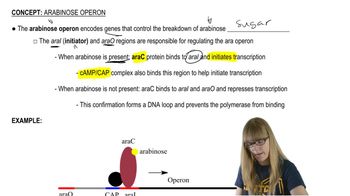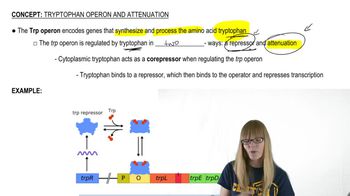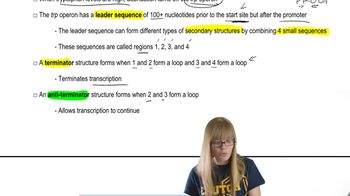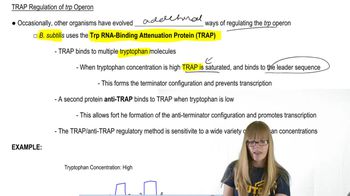Table of contents
- 1. Introduction to Genetics51m
- 2. Mendel's Laws of Inheritance3h 37m
- 3. Extensions to Mendelian Inheritance2h 41m
- 4. Genetic Mapping and Linkage2h 28m
- 5. Genetics of Bacteria and Viruses1h 21m
- 6. Chromosomal Variation1h 48m
- 7. DNA and Chromosome Structure56m
- 8. DNA Replication1h 10m
- 9. Mitosis and Meiosis1h 34m
- 10. Transcription1h 0m
- 11. Translation58m
- 12. Gene Regulation in Prokaryotes1h 19m
- 13. Gene Regulation in Eukaryotes44m
- 14. Genetic Control of Development44m
- 15. Genomes and Genomics1h 50m
- 16. Transposable Elements47m
- 17. Mutation, Repair, and Recombination1h 6m
- 18. Molecular Genetic Tools19m
- 19. Cancer Genetics29m
- 20. Quantitative Genetics1h 26m
- 21. Population Genetics50m
- 22. Evolutionary Genetics29m
12. Gene Regulation in Prokaryotes
Tryptophan Operon and Attenuation
Problem 1
Textbook Question
In this chapter, we focused on the regulation of gene expression in bacteria. Along the way, we found many opportunities to consider the methods and reasoning by which much of this information was acquired. From the explanations given in the chapter, what answers would you propose to the following fundamental questions? How do we know that the trp operon is a repressible control system, in contrast to the lac operon, which is an inducible control system?
 Verified step by step guidance
Verified step by step guidance1
Understand the basic concepts of operons: An operon is a cluster of genes under the control of a single promoter and is transcribed as a single mRNA. The trp operon and lac operon are classic examples of operons in bacteria.
Identify the type of control system: The trp operon is a repressible operon, meaning it is usually active and can be turned off (repressed) when a specific molecule is present. In contrast, the lac operon is an inducible operon, meaning it is usually inactive and can be turned on (induced) when a specific molecule is present.
Examine the role of the repressor protein: In the trp operon, the repressor protein is inactive by default and becomes active when tryptophan (the end product) binds to it, allowing it to bind to the operator and block transcription. In the lac operon, the repressor protein is active by default and becomes inactive when lactose (or allolactose) binds to it, preventing it from binding to the operator and allowing transcription.
Consider the feedback mechanism: The trp operon is regulated by a negative feedback mechanism where the presence of tryptophan inhibits its own synthesis by activating the repressor. The lac operon is regulated by a positive feedback mechanism where the presence of lactose induces the operon by inactivating the repressor.
Analyze experimental evidence: Researchers have used genetic and biochemical experiments to demonstrate these mechanisms. For example, mutations in the trp operon that prevent repressor binding result in continuous expression, while mutations in the lac operon that prevent repressor binding result in continuous repression.
Recommended similar problem, with video answer:
 Verified Solution
Verified SolutionThis video solution was recommended by our tutors as helpful for the problem above
Video duration:
1mPlay a video:
Was this helpful?
Key Concepts
Here are the essential concepts you must grasp in order to answer the question correctly.
Operon Model
The operon model is a genetic regulatory system found in bacteria, where a group of genes is controlled by a single promoter and regulated together. This model helps explain how genes are turned on or off in response to environmental changes, allowing bacteria to efficiently manage their metabolic processes.
Recommended video:
Guided course

Arabinose Operon
Repressible vs. Inducible Operons
Repressible operons, like the trp operon, are typically turned off and can be inhibited by the presence of a specific molecule, such as tryptophan. In contrast, inducible operons, such as the lac operon, are usually off and can be activated in response to an inducer, like lactose, allowing the bacteria to adapt to different nutrient sources.
Recommended video:
Guided course

Induced Mutations
Gene Regulation Mechanisms
Gene regulation mechanisms involve various processes that control the expression of genes, including transcription factors, repressors, and activators. Understanding these mechanisms is crucial for distinguishing between different operon types, as they dictate how and when specific genes are expressed in response to cellular and environmental signals.
Recommended video:
Guided course

Review of Regulation






